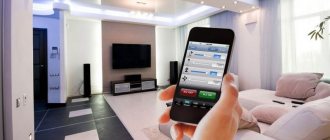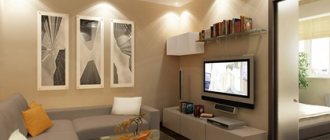Example of chandelier repair
What is shown here is not exactly a repair, but one might say a modernization towards simplification.
The photo below was sent to me by a reader:
The chandelier does not contain LEDs at all, however, the principle of its operation and repair is absolutely the same. A reader complained to me in a letter that the chandelier began to respond poorly to commands from the remote control. I advised changing the controller. However, the reader admitted that he does not like remote bells and whistles, and he is not going to spend more than 800 rubles (control over 3 channels).
As a result, on my advice, the radio control unit was completely excluded from the chandelier, and power was supplied from a conventional three-key switch.
It is worth saying that before this, the electronic transformers of halogen light bulbs were replaced, and some groups had to install 2-3 transformers instead of one, because there was no suitable one in terms of power and dimensions.
That's all, good luck and good lighting everyone!
LED lighting continues to successfully capture the global market, providing excellent energy efficiency along with flexibility and versatility in use. However, LED lights are still expensive to manufacture due to the high cost of LEDs and the design of the heatsinks. However, rather than competing with other light sources on energy savings alone, LED product manufacturers are trying to differentiate themselves in the market by offering more sophisticated features.
LED lighting control system components and prices
LED lighting is controlled using a number of components:
- RGB controller (from the English Red, Green, Blue - Red, Green, Blue) - a single-channel controller with a built-in LED driver that allows you to control the three above-mentioned colors using the programs built into it;
- Multi-channel RGB controller – has several channels (three or more) of LED lighting control, which allows it to perform complex lighting scenarios;
- DMX RGB controller is a device that connects LED lighting to a computer via the DMX 512 protocol. In this case, the light is controlled using special software. The device allows you to use up to 512 light control channels;
- DALI RGB controller – allows you to control large LED systems via the DALI protocol. Using this controller makes it possible to manage 12,800 devices at once;
- Dimmer – is a device for adjusting the brightness of light. Our website is dedicated to dimmers, so we won’t dwell here for long;
- Repeaters are unique amplifiers for RGB controllers that allow you to increase their power.
Here are the approximate prices for some of these devices
As you can see, there are devices for every taste and color. Now let's talk a little about the LED products themselves.
Flexibility and functionality of LED products
For example, LED lights can easily provide a variety of colors, meaning the same bulb can produce warm or cool white light, or any color in the spectrum. Compact fluorescent lamps cannot provide a similar capability. LED luminaires are also smarter with connectivity capabilities, allowing them to perform better, offering more flexible control, diagnostics and automation of certain functions. One of the most global systems is the Powerline network, which provides the communication interface and serves as the main element.
Modern technologies allow the use of special buses that provide a high level of reconfiguration and the ability to control multiple devices through a single controller. This controller can control all the light bulbs and fixtures in a room or even the entire house. In addition, the bus topology allows the use of several controllers to control one luminaire. Thus, a lamp in one room can be controlled from another (that is, all lamps in the house can be turned off, for example, from the bedroom). This topology also allows the controller to keep track of all devices on the network and serves as a basis for expansion and has a plug-and-play feature where any new luminaire can immediately become part of the network.
Powerline system
Powerline includes a transceiver, usually low voltage, with DC power. To interface this device with Powerline, an amplifier and communication circuit are not required. The communication circuit can be modified to support the required voltage range (e.g. 110-240 VAC for residential applications, 24 VDC for pool lighting, etc.) and hence the Powerline transceiver can be used for any desired range stress.
The appearance of the controller can be very diverse, depending on the location and level of control that is required. Located on the wall, the lighting control interface can look like a simple switch, as well as one or more dimmers for individual color control of fixtures. In addition, sometimes a button is needed to index existing luminaires and one button to bind to a network node.
Typically, a microcontroller is used to process these functions and integrate them into the Powerline transceiver interface. With Cypress Powerline communication technology, for example, the microcontroller and transceiver are integrated so that data processing, network communications and the lighting control system are controlled by a single device.
An innovative approach to replacing clunky physical buttons, switches and dimmers is the use of capacitive touch sensing, which provides the user with an easy, convenient and reliable interface to control the lighting in the home.
Video: Remote lighting control
Imagine: you drive up to your house, open the gate, and the lights in the garage and on the driveway immediately turn on, as well as the lamps along the path leading to the house, and the house lamp - now you no longer have to make your way to the switches in the dark. Or another example: you climbed under a warm fluffy blanket in bed and decided to read a book, and you’re too lazy to get up and turn off the ceiling lighting; you can use a special remote control to turn off the excess light and leave only the bedside sconce. All these small but important advantages of the development of technical civilization are provided by remote control of lighting. In this article, we will tell you what lighting control systems there are, what devices can be used for this, and what types of signals.
Lighting control systems
Lighting control can be organized in various ways. This can be control of all lighting fixtures in a house or apartment from one controller installed in a convenient location, or from one remote control that allows you to turn lamps on and off in different rooms, and it is also possible to control lighting automatically according to a pre-defined scenario or trigger the corresponding sensor. Most of the functions related to lighting control can be performed by the smart home system. It is capable of combining all the systems that will be listed below.
Centralized lighting control
In very large houses and industrial enterprises, for convenience, group panels are installed for centralized lighting control. For example, if the building of a bathhouse, guardhouse or barn is no longer needed, the lighting in them can be turned off from the main building from the central control panel. In this case, control can be carried out directly in hardware on a common panel, or perhaps on a separate special controller.
In an ordinary apartment, a common controller is sometimes installed near the front door. When you're in a hurry getting ready for work, turning the light on and off behind you is sometimes simply inconvenient, because you're rushing here and there. And so, when leaving the house, you can press a button and turn off the lighting in the entire apartment at once.
The most convenient and advanced is centralized control from a computer or even from a mobile device in any part of the world. But this is already a remote control option.
Remote lighting control
Lighting can be controlled from a distance in a variety of ways. For the most common and accessible lighting remote control
, which looks very much like a regular TV remote control. Most often it has from 4 to 7 buttons, each can control one group of devices. Each group can have from 1 to 262 devices.
Using the remote control, you can not only turn on and off lighting fixtures in a particular room, but also adjust their brightness. For example, while lying in bed, you can turn off the overhead lighting and leave only the bedside sconce, or in the living room, dim the general light for a romantic dinner.
Using remote control of lighting in an apartment does not always make sense, since the need to turn on or off a particular lamp is in one way or another connected with moving around the apartment. For example, supporters of remote control always give an example of how convenient it is to turn off the light in the kitchen from the bedroom, which you forgot to turn off when leaving it. You might as well forget the remote control in the kitchen. And if several people live in an apartment, should everyone have their own remote control? How to determine who will turn off the light forgotten in the corridor? Or another example: remotely turning on the lights in the toilet and bathroom, how necessary is it? In any case, the light in the toilet may be needed only for the specific purpose of visiting it, what prevents you from flipping the switch when entering? Well, if you’re really lazy, then you can install motion sensors - the lights will turn on when someone enters the room, and turn off when they leave.
The only more or less meaningful indication for using remote control of lighting in an apartment
is multi-tiered lighting, when ceiling lamps, a central chandelier, wall lamps, sconces, and also decorative lamps in niches are installed. In general, when you see a miracle of design thought. Then actually turning off some of the lighting in the room without getting up from the couch is convenient and advisable.
But the most justified is remote control of outdoor lighting
. The height of functionality is to regulate the lighting of the local area, technical buildings and alleys from one remote control, without leaving the house. It is also very convenient to control decorative elements: lighting of flower beds, fountains, ponds and green areas from the smart home controller.
In addition to the large full-fledged control panel, you can use a small remote control - key fob
with a limited number of functions. For example, just to open the gate and turn on the light near the front door of the house or in the garage.
Lighting control from a computer located in the same house
, very convenient if there is no remote control nearby. Typical software solutions for a smart home system can be installed on a computer and be able to fully regulate all lighting groups and devices.
Lighting control from a computer anywhere in the world
is carried out in this way: using a special program and password identification, you need to log directly into the home control device or intermediate server and turn on or off the lighting fixtures in a particular room. This is very convenient if you forget to turn off the light, or to create the effect of presence.
Lighting control using a smartphone
provided using a special client software application. In many ways, this control is similar to the previous method, only from a less functional device.
It is even possible to control it from a regular cell phone by sending encrypted SMS, this is called GSM control.
The easiest way to remotely control lighting is a wall controller
. When the last occupant of the home leaves the house, he can press a button and turn off the lights in all rooms. And when he comes home, the light turns on only in the hallway or corridor.
Automatic lighting control
Using automation such as motion sensors, photocells and timers to control lighting is very convenient. For example, motion sensors
and no longer bother wondering if I forgot to turn off the light in the toilet. According to the given program, a minute after they left it, the light will turn off by itself. The use of motion sensors is convenient if there are small children in the house who simply cannot reach the switches. And so the light will accompany them everywhere.
Allows you to adjust the intensity of artificial lighting depending on the general illumination. For example, with the onset of deep twilight, the lighting near the front door of the house and the illumination of alleys and paths are turned on. And with dawn, all artificial lighting turns off on its own.
Lighting control using a timer
used in cases where the lights need to be turned on and off according to the clock. For example, 5 minutes before the owner arrives from work, if he has a normal schedule. Or turning off lighting and outdoor advertising during dead time, from 02:00 at night to 05:00 in the morning.
Lighting control devices
Various devices and devices are used to control lighting. Some of them are direct controls, others are auxiliary sensors or devices, receiving information from which the first ones are triggered.
Used to remotely control a group of luminaires. Connects to lighting fixtures of a specific group. When you press the button, it turns the devices on or off forcibly.
There are also blocks that allow you to control a lighting group using a regular remote control from a TV or other equipment. The buttons on the remote control can be selected arbitrarily and then programmed for specific actions. The block allows you not only to turn the light on and off, but also to adjust the brightness, as well as turn off the light using a timer.
The controller is a functionally complete automatic machine, capable of controlling lighting in automatic mode according to a given program, in remote mode from the remote control or according to information received from sensors, as well as in manual mode using buttons. Programming of the controllers is carried out using the built-in keyboard and LCD display.
The lighting control circuit using the controller is shown in the figure.
Lighting control sensors
Installed in rooms where automatic control of light is planned depending on the presence of people in it. Pyrosensors of the sensors detect thermal radiation from people and animals, send a signal to the control device, which turns on the light or turns it off if the room is left. The operating principle of motion sensors is based on IR radiation (infrared), which does not pass through natural barriers such as walls. If there is someone in the next room, the sensor will not trigger.
Captures the luminous flux of natural light. If the intensity decreases to a predetermined threshold, the sensor transmits a signal to the control device, which turns on the lighting, for example, in the evening or cloudy times. Such sensors are mainly used only for automatic control of external lighting of alleys, technical lighting of buildings, terraces, etc.
Remote controlled switches
Like modern televisions, stereo systems, DVD players and other devices controlled using infrared rays, the first to appear were switches, sockets and dimmers that respond to infrared rays. Control occurs using an infrared remote control, which must be pointed clearly at the IR receiver on the switch. In this regard, control is possible only within line of sight, but not in other rooms.
Radio controlled switches
allow you to control lighting in different rooms and beyond at a distance of up to 100 m through any obstacles that reduce the signal level, but do not block it completely. The frequencies used for radio control of lighting, 433 MHz and 868 MHz, are specifically designed for this purpose, so that air pollution does not occur. Sometimes special adapters are produced that convert IR radiation into radio frequency.
GSM controlled switches
allow you to control lighting from your phone remotely. Using a special program installed on your phone or smartphone, you can turn off or turn on the lights in the house, no matter where you are.
Lighting control panel
For remote control of lighting, both IR and radio-controlled remote controls are used. In some cases, you can use a regular TV remote control by reprogramming it accordingly.
Radio-controlled remote controls are now in demand, as they have sufficient functionality. They can have up to 7 - 9 buttons that can control different lighting groups. Each group has its own address. When you press the button, the signal goes out to all groups at once, but only the group whose address matches is responded.
Smart home systems use remote controls that allow you to regulate and control not only lighting, but also all appliances and electronics in the house.
Photocells must be installed in places where there will be no illumination from lamps, so that false alarms do not occur. The device does not respond to temporary flashes, such as lightning or car headlights, only to the general level of illumination.
Timers or time relays
A time relay is used when it is necessary to control lighting according to a specific schedule. For example, outdoor advertising lighting needs to be turned on at a certain time and turned off too. Turn off the street lighting of the garden or local area at night and turn it back on before dawn. The built-in processor itself determines the time of sunrise and sunset and calculates the required time.
All these devices and appliances are designed to simplify our lives and make it even more comfortable. The simplest remote lighting control systems do not require replacement of wiring or additional wires; it is enough to replace switches or install special units in chandeliers. But for more serious control using the smart home system, you will have to form a serious network connecting all devices.
DIY chandelier repair
There are actually only two faults in such chandeliers, and both can be fixed with your own hands, now I’ll tell you how.
A chandelier with a remote control does not turn on using the remote control or switch
This is the most common malfunction - the chandelier does not turn on at all. We must first check the obvious - the batteries in the remote control and the power supply to the chandelier. The switch may be faulty or there is no contact on the ceiling.
Then act according to the circumstances. Often, if there is power, but the entire chandelier does not turn on, the controller (receiver) is faulty. If it’s part, you need to look at the lighting groups.
Chandelier with remote control clicks but does not turn on
Clicks when trying to turn on from the remote control or from the switch indicate that most likely the chandelier controller is working. As a rule, not all groups are included at once, but only one or two.
Each lighting group is switched on by its own controller output. And since the controller output has a voltage of 220 V, additional power supplies are used to power LEDs and halogen lamps. You need to make sure that when you turn on the corresponding group, a voltage of 220V appears at the input of the desired power supply. If there is no voltage at the output, either this unit is faulty or the output is short-circuited.
Below there will be diagrams and real examples, it will be clearer.
Repair often comes down to replacing the control panel complete with receiver, controller, electronic transformers and is not particularly different from the repair of other chandeliers.
A couple of things to renovate
It also happens that when one group in a chandelier does not turn on, the problem is in the LEDs connected in series. If a break occurs in one of them, then all of them do not burn.
In addition, I would like to warn against installing overly powerful halogen lamps. This will either burn out the transformer or the cartridges. And changing cartridges in such chandeliers is the most difficult thing to repair.
Changing the controller often is expensive, difficult and not particularly necessary. In this case, I suggest removing the chandelier control unit with the remote control altogether, and connecting the lighting groups through a regular switch. Cheap, in our opinion.
How to prevent sparks
To prevent sparks from forming at the contacts, manufacturers install arc suppression chambers that cool the arc. Some brands may make solderings from materials that are not susceptible to oxidation. Current will pass through them. You can use several methods yourself.
Spark arresting circuits
Suitable for high-speed devices that generate sparks at the moment of closing. Most often there are two options:
- For relays and DC starters. You will need a diode with an anode on the negative pole and a cathode on the positive pole. Energy dissipation occurs on the active part (self-induction). The diode will close the circuit.
- Snubber. The shunt RC circuit is designed to dissipate the energy accumulated in the inductance at the moment of active resistance of the network.
The contacts are located close together, so the spark extinguishing circuit reduces the load.
Pressure plates
The method is suitable for sparking contacts of a starter or machine. A special spring mechanism ensures tight contact between the contact pads. To connect, you will need to install a spring mechanism in the closed contact position, retracting it and lowering it back. A click/thump should be heard.
The work is carried out in a network without voltage.
Removing carbon deposits
You can clean the surface of conductors not only with fine sandpaper. An eraser or a wooden match will ensure a smooth surface and eliminate the risk of increasing contact resistance.
If the wiring is faulty, a cracking sound appears in the light switch when turned on. Occasionally the phenomenon is accompanied by sparks. It will be easy for people who know how to work with electrical equipment to find and fix the problem.











